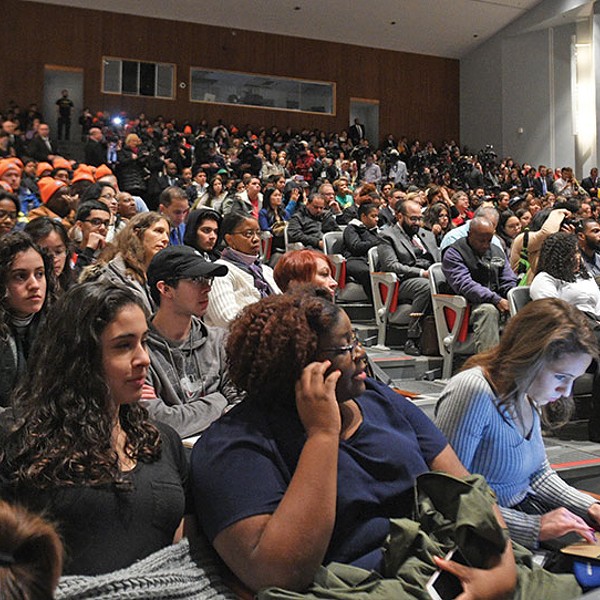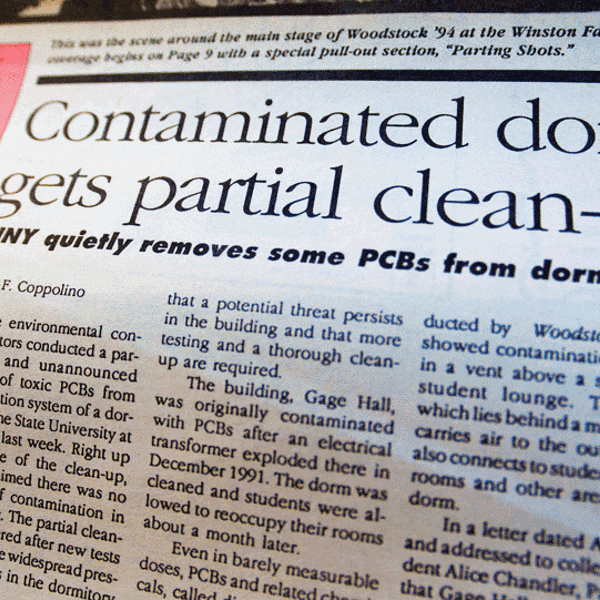“Nobody wants to hear that there’s no way to say it’s safe.”
So said Edward Horn, director of the Division of Environmental Health Assessment for the New York State Department of Health, in an interview last month. Perhaps the most candid comment I’d ever heard from a state official in 16 years of covering the PCB and dioxin disaster at SUNY New Paltz, Horn at least understands one thing: When you live in one of the four dorms affected by 1991 transformer explosions and fires—Bliss, Capen, Gage, and Scudder Halls—you are living in a place where there is contamination.
After more than $50 million spent on testing and cleaning so far, the question is whether students will be exposed to that contamination, and, if so, how it will affect them. This has been debated through the spring and summer by campus leaders, community organizers, and county and state officials from a variety of different agencies, including the SUNY New Paltz administration and its remediation contractor, Clean Harbors.
The result of all these meetings: There will be no additional tests of the dorms before they reopen on August 21. The college may put together a summary of what happened so that it can respond to queries from students and parents, but that is unlikely to include a warning about the safety of the buildings or lack thereof. College officials consistently tell parents that the buildings are safe but do not mention that cleanup plans specifically granted permission not only to leave “acceptable” levels of contamination, but also that these levels could kill a certain number of students.
No scientific study can definitively state that there is a safe level of exposure to the toxins. This is to say, where there is exposure, there will be an effect somewhere in the population. It is difficult, if not impossible, to precisely predict where or when.
Even at barely measurable and ever-tinier levels, these chemicals are known to disrupt the body’s hormones, suppress the immune system, cause birth defects, and in study after study are shown to be potent cancer accelerators. What does “ever-tinier” mean? Fifteen years ago, Greenpeace dioxin expert Fred Munson said that as little as one part per billion of dioxin lodged in the human body was probably dangerous. This is called the body burden. Today it’s known that the current average body burden of about 10 parts per trillion (100 times less than the old estimate) will cause cancer in up to 10 percent of the population.
No company has ever produced dioxin as a consumer product. Dioxins, usually considered far more toxic than PCBs, are created not only when PCBs burn or decompose with use, but were also present as contaminants in original products new from the factory. PCBs were widely manufactured for more than five decades. Though listed as a “probable human carcinogen,” PCBs are one of the few chemicals ever to be banned by name by Congress, under the Toxic Substances Control Act of 1976. That was more than 30 years ago, but PCBs were so widely used and so environmentally persistent that they remain a health concern, turning up in places like farmed salmon, meat and dairy products—and college dorms.
Dioxins and PCBs are bioaccumulative. Each dose adds to what is already there. They also affect the children of those exposed. According to a new study from the Netherlands that followed mother-child pairs for 15 years, children of dioxin exposure victims typically show problems by age 8. These include measurable delays in puberty, such as breast development and first ejaculation, as well as other developmental issues. Dioxin exposure in the father has also been linked to childhood vaginal cancer in their daughters.
“Most students are planning to have families. Exposure in the dorms is not a good idea. Dioxins tend to bioaccumulate and so do PCBs,” says Erik Janssen, the executive director of Department of Planet Earth, an environmental group that focuses on dioxin.
While state officials point to reams of test results saying levels of toxins in the dormitories are, at worst, within the state’s acceptable limits, the other side of the story is what areas were not tested. That means no data exists for certain locations and therefore the toxin levels are unknown.
Untested areas include the heating systems in Capen, Gage, and Scudder halls; exhaust vents in Capen Hall; electrical conduits in Capen and Gage; and many other areas.
Vents in Gage Hall were first sampled in 1994, two years after the building was reoccupied by 370 students, and were found to have been contaminated throughout. They were cleaned to “arm’s length,” but recent independent testing done for this column indicated that contamination levels in the Gage vents are close to their original, pre-cleanup levels. There is no follow-up testing of ventilation ducts in the places where they were worked on, and there has been neither testing nor cleanup of the vents in Capen Hall at any time.




















